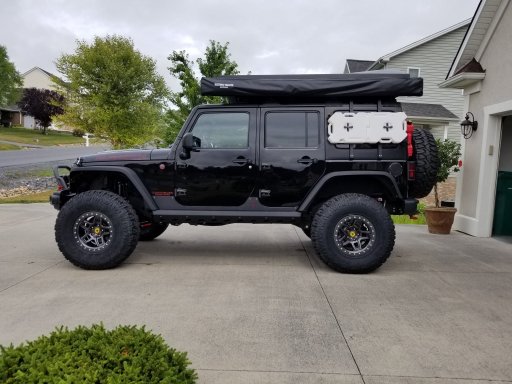I generally don't respond to threads like this, because mostly people will do as they wish with their vehicle and that's pretty much the end of the story. But in this case, I've started several responses and then deleted them for not wanting to wade in. Finally, I might post this one, NOT as a response to what anyone here has posted about what they can or can't do with their own vehicle, but rather because someone newer to the topic should perhaps understand what Curb Weight, GVWR, GAWR, and GCWR are and how they are set by the vehicle manufacturer, and what that means for their vehicle.
First, let's lay down a couple definitions:
Curb Weight: weight of the empty vehicle with full fluids (fuel etc)
Gross Vehicle Weight Rating (GVWR): Maximum weight for which the vehicle is designed, including fluids, passengers, and payload
Gross Axle Weight Rating (GAWR-front/rear): Maximum carrying weight for which each axle is designed
Payload: GVWR minus (Curb Weight + tongue weight of any trailer)
Next, let me talk about a misconception: GVWR and GCWR are NOT selected by the engineers. Nope. Not even close. Rather, the manufacturers do a ton of market research. The marketing departments study their entrails, tea leaves, and observe omens in the form of birds, to determine that for a particular market segment they believe would generate revenue, that a particular PAYLOAD would meet the needs of some percentage of that market - they'll typically pick some number in the 80-90% range and the 10-20% of the market segment that needs more will have to go somewhere else. This is how the payload is chosen. Unfortunately, because the bottom 80% of payload needs are probably dominated by mall crawlers, we, as a community, probably fall nearer (or over) the top of the payload range.
After marketing selects the payload, THAT is when the engineers get involved. Marketing tells engineering: design us a vehicle for market X that will carry payload Y. And this is what the engineers do. BUT they know vehicles don't just sit, they *move*. They also know not all roads are smooth, they have bumps. So the vehicle's suspension is designed to CONTROL this payload in motion and the vehicle's frame, chassis, and body are designed to withstand the fatigue cycling of a lifetime of bumps with that payload. (The drive line, cooling, and brakes are designed additionally considering pulling weight of a trailer on reference grades like the Eisenhower Grade in Colo, or the Baker Grade in Calif, keeping in mind that trailers may also have brakes.)
So what do you give up when operating a vehicle over it's GVWR?
- Control/Safety. The emergency handling capabilities of the vehicle will be severely impaired. As a community, we often talk about adding heavier springs/shocks to help control the vehicle's weight in motion, but this only goes so far. Most vehicles are designed so that the vehicle's center of gravity sits roughly on a plane resting atop the stock tires when when the vehicle is empty. As we add lift and as we add payload above that plane, we raise the vehicle's center of gravity - it becomes more "tippy" or as one person above noted, "it handles like a fat/drunken cow". So while we can stiffen the suspension, we can't change the fact that we've raised the center of gravity, even more so when we overload the vehicle.
- Vehicle Lifetime. Metals flex and stretch, to a point. That point (stress) is defined by the force being borne by the cross-sectional area of the material, and whether the force is stretching the material (tensile stress) or shearing the material (shear stress). We measure the "ultimate strength" of materials, by applying an increasing force until the material breaks. Once. You may have heard this called the "tensile strength" of a material. But we don't stress vehicles just once, so we need to understand a second "strength" - "fatigue strength". Every time we stretch or flex a piece of metal, we create micro-cracks in the metal's crystal structure. Every Time. You can see this yourself by taking a piece of metal and bending it back a forth several times - it gets warm, it gets easier to bend, and eventually it breaks - much easier than if you'd tried to just pull it apart in one go. This progressive "softening" or "weakening" of the metal occurs because the cracks are decreasing the cross-sectional area as they form, grow, and eventually grow together into a fracture. This damage accumulates - it doesn't heal, it doesn't buff out. However, there is a stress point below which these cracks do NOT form as steel is flexed - ie. a line between small flexes that don't create micro-cracks and bigger flexes that do create micro-cracks - this is often referred to as the fatigue strength of the material. Based on usage information from their (probably mall-crawling) customers and(probably paved) road data (including potholes), etc, the engineers can calculate how large to make the vehicle's structural components and welds so that the vast majority of customers(mall-crawlers included) won't see a structural failure in the vehicle's lifetime. When a vehicle is run on rough roads, it accumulates "flexes" faster than on smoother paved roads, but as long as we stay below the fatigue strength of the components, we won't see much increase in failures. However, if we overload the vehicle, we can see dramatic (2x-10x) reductions in the the vehicle's structural integrity lifetime. ( Remember how soft that flex piece of metal gets before breaking? You've seen that farm truck that lived fast and died hard exclusively on washboard dirt roads, haven't you?) The most dangerous thing about fatigue failures is that they almost never occur during the overload - rather, the overload shortens the component life and it fails early, often at a time when the overall load wouldn't have been otherwise problematic. I mentioned welds earlier, because they can often be particularly susceptible to fatigue, and thus are generally designed with fatigue in mind.
Putting this together, the GVWR is sort of a promise made by the manufacturer, that as long as one doesn't exceed that weight, the vehicle should not see any structural failures over the expected lifetime of the vehicle, nor should the vehicle experience significant control/safety issues under normal operation. Because this is the manufacturer's promise, you can't change it. (Which is not to say that you couldn't weld/bolt additional structure onto a vehicle to keep the components below their fatigue strength, but that isn't a trivial undertaking.)
So, it's your vehicle. Understanding the issue, you can make the trade-off, between load, vehicle lifetime, and control/safety. If you load your pickup bed with rock, you make the trade off, by driving slow on smooth roads while hauling that load. If you plan to rock-crawl an extremely rough and technical trail, lighten up and go slow. Make the trade-off.
Wow. Apologies. That got long. At this point I'll direct the reader to other threads about choosing lighter armor/gear and sign off.















